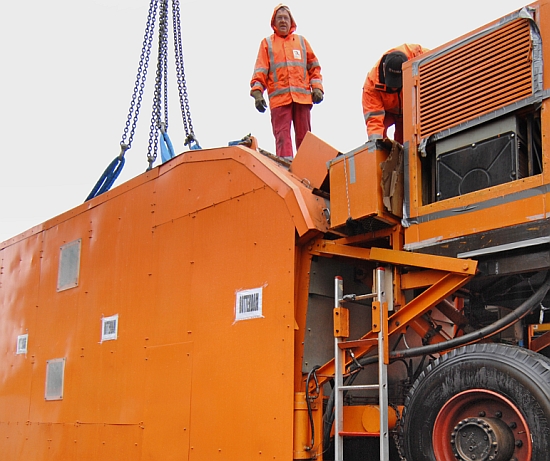A unique and very large mobile traffic load simulator will test the asphalt rapidly and thoroughly
A new «stress-tester» for Swiss roads
A road-traffic load simulator as large as an articulated lorry has arrived at Empa. The machine is designed to proof road surfaces and indicate when any renovation work is due. Before the monster vehicle, which is twelve meters long and three high, is let loose on Switzerland’s roads, though, it will spend the next three months under the watchful eyes of Empa specialists, proving that it can indeed do what it promises, i.e. load a roadway so heavily that its surface ages and wears in a fraction of the time it would take under normal usage.

|
«This machine is unique, world-wide a one-of construction – and it was built at our initiative», says Manfred Partl not without pride. Partl heads Empa’s Road Engineering and Sealing Components Laboratory which, among other tasks, researches, develops and tests wear-resistant, long-life and low-noise roadway surfaces. After all, a roadway is expected to last at least thirty years without turning into a permanent traffic bottleneck due to constant repair works. It is the never-ending temperature swings from summer heat to winter frosts, which cause the greatest problems. If the temperature change is extreme, falling to well below freezing, then the asphalt shrinks, causing cracks. In addition, on heavily used roads dangerous surface grooving may develop, leading to aquaplaning and consequent accidents during rainy weather. |
||||
|
From idea to mobile monster The idea of obtaining a large testing machine for accelerated traffic-load simulation germinated in 2004. The new plant would replace the ETH Zurich’s aging asphalt testing system on Empa’s premises. One critical requirement that the new machine had to fulfill was that it had to be mobile, so that it could perform road tests on location. Previously the roadway had to come to Empa, so to speak – Empa specialists would investigate a section of roadway cut out from the original location to see if it needed repair or renovation. With the new mobile simulator entire streets can be summarily tested, in situ. The huge machine named «MLS10» simulates the effect of 6000 tire roll byes per hour using four load wheels mounted on a rail and operating round the clock. «Our machine can inflict in about two weeks the same level of wear seen in a whole year by a heavily used road such as the Rosengartenstrasse in Zurich», explains Partl. This is the ultimate stress test! |
|||
|
The simulator was constructed by a South African company based in Cape Town, to a design by the University of Stellenbosch, and initial tests were conducted in Mozambique. In collaboration with the ETH Zurich’s Institute for Geotechnical Engineering, Partl’s team initiated a research project with the intention of evaluating the testing machine and, if it gave satisfactory results, establishing it in Switzerland. Partl and his colleague Markus Caprez of the ETHZ were in Mozambique as the prototype was being put through its paces, testing every detail of its operation. Their verdict: excellent at producing road wear, but hellishly noisy! «We could never have used it Switzerland given the racket it made initially», says Partl. Only after the South Africans fitted the machine with a sound reducing enclosure and placed acoustically absorbing matting around its noisiest parts was the monster allowed to enter the country. Practical tests on Swiss motorways «Now we hope that our simulator will do horrible things to Switzerland’s road system», says Partl. The section of roadway on which the machine will perform its first continuous load test is on an extension of the Oberland Motorway near Hinwil in Canton Zurich. «Road traffic won’t be affected by the trial», he continues. After two weeks of load simulation the level of damage will be evaluated. How long the simulator will remain at this location depends on the length of time it takes to destroy the stretch of road. Partl believes it will take a maximum of two months. |
||||
|
If the giant simulator meets its intended specifications, it is as good as sold, and will then be operated jointly by Empa and the ETHZ’s Institute for Geotechnical Engineering. It will be expected to tackle a daunting set of tasks. On the one hand it will monitor and test existing road surfaces, which together after all form the longest civil engineering constructions in the country. About three thousand million Swiss francs are spent annually on repair and maintenance of the 1600 kilometers of national roadways alone. «The simulator helps us to determine how much life is still left in the asphalt road surface», explains Partl. This information enables the engineers to determine the optimal moment for repair work, so that a roadway remains smooth and crack-free for as long as possible. The potential savings are enormous. |
|||
|
Furthermore, the new simulator is expected to help breathe new life into researching new building materials and surfaces. Open pore asphalt, known popularly as «whispering asphalt», enjoys many advantages over the standard sort. It is less noisy to drive on and it absorbs rainwater like blotting paper. However, based on previous experience experts fear that it is mechanically less resistant to wear and has a shorter lifetime than classical asphalt concrete. Additionally, using the large simulator enables researchers to develop and evaluate under realistic traffic and weather conditions other hardwearing road surface materials, for example armored varieties or recycled used materials. The Dino, as Partl calls his new toy, «….enables us to react quickly and economically with new road surfaces to changing traffic, climatic and environmental requirements. With our previous mini-simulator this was only possible in a limited kind of way.» |
||||
|
Technical information: Prof. Dr. Manfred Partl, Road Engineering and Sealing Components Laboratory, Ph. +41 44 823 41 13,
Editor: Dr. Sabine Borngräber, Communication Dept., Ph. +41 44 823 4916, |
||||
|
|||


